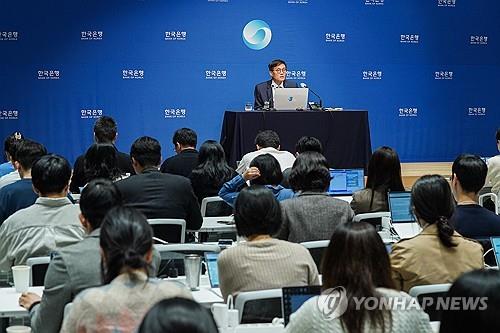The weak economic momentum, along with the hope for the Federal Reserve’s rate freeze next month and moderating inflation, may prod South Korea’s central bank to keep its policy rate unchanged again this week.
But the Bank of Korea (BOK) is likely to say that it will keep its restrictive monetary policy stance amid still high inflation and soaring household debts.
On Thursday, the BOK is widely predicted to leave the rate, which currently stands at 3.5 percent, unchanged, which would be the seventh straight rate freeze in the face of a murky growth outlook, according to a survey of 13 economists by Yonhap Infomax, the financial data firm of Yonhap News Agency.
The series of rate freezes comes after the BOK delivered seven consecutive hikes in borrowing costs from April last year to January.
South Korea’s economy has been dogged by slumping exports and sluggish consumer spending. For the year, the central bank had expected Asia’s fourth-largest economy to expand 1.4 percent this year, but it is still unclear whether such a forecast would be achieved in the face of a still murky economic outlook.
Weak global demand, led by China’s slowing economy, and a delay in the recovery of the IT sector have been blamed for a slump in the country’s outbound shipments.

But recently, the country’s exports have shown signs of recovering. South Korea’s exports rebounded for the first time in 13 months in October, driven by robust auto shipments, along with signs of an improvement in the chip sector.
Outbound shipments moved up 5.1 percent on-year to US$55 billion last month and logged a trade surplus of $1.64 billion in October, the fifth straight gain.
This week, the central bank will announce its updated growth outlook for the year and next year as well.
The economy grew 0.3 percent, 0.3 percent and 0.6 percent, respectively, in the first, second and third quarters.
Policymakers have also pinned hopes on easing inflation, helping the central bank take a breather in its rate hike moves.
South Korea’s inflation grew at a faster pace of 3.8 percent in October, staying above 3 percent for the third consecutive month, due to higher prices of energy and farm goods.
It is the third month in a row that the annual price growth has picked up pace.
But oil prices have been stabilizing in the face of the Israel-Hamas war, possibly helping inflation ease down the road, a development that supports the central bank’s rate freeze.
The central bank is also paying keen attention to rising household debts.
Household loans extended by banks in South Korea rose for the seventh straight month in October, led by rising home-backed loans amid high borrowing costs.
Banks’ outstanding household loans reached a record high of 1,086.6 trillion won (US$833.6 billion) at end-October, up 6.8 trillion won from a month earlier, accelerating from a 4.8 trillion-won rise the previous month and marking an on-month increase for the seventh month in a row.
Early this month, the Fed held its benchmark lending rate steady at a 22-year high for the second consecutive time as it keeps striving to bring down inflation to its 2 percent target.
The Fed kept the rate between 5.25 and 5.50 percent. But it left open the possibility of a rate change later to achieve “maximum” employment and its inflation target.
Next month, the Fed is widely expected to stand pat again.
Source : Yonhap News Agency









